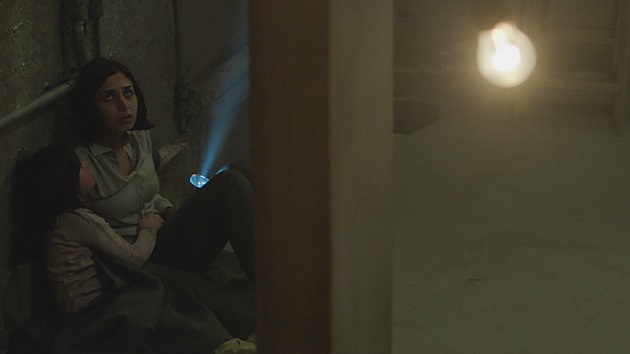In Tehran, after the revolution but still in the middle of conflict, Shideh (Narges Rashidi) pleads with the director of her medical school. She left to be an activist during the revolution and now wants to return to her studies, but because she chose the wrong side is not allowed to re-enroll. Heartbroken, she goes home only to find out her husband, also a doctor, is being drafted to help the military. Tehran is a major target for bombings, so he advises that Shideh take their daughter Dorsa and go to his parents in the north where they will be safe. Upset and stubborn, Shideh says she will stay. She soon learns that there is more to be afraid of than the bombings.
Under the Shadow is a multilayered film and builds fear with each additional wrinkle. There is the physical threat of bombings that constantly looms over the characters, but Shideh is also dealing with her own failure and is questioning her ability to protect Dorsa by herself. On top of this, there are the supernatural elements. Why is Dorsa’s doll missing? Why won’t her fever break? What are the things she and Dorsa keep seeing? As Shideh tries to deal with these fears, she begins to crack under the pressure. Everyone in her building starts leaving the city so she has the additional fear of being alone in the building. Each of these aspects increases the baseline level of fear. Even if they are safe in one respect, there are still several other dangers to be afraid of.

Director Babak Anvari adjusts the camerawork to match the emotion of the film. Rather than maintain the same shooting style throughout the movie, he shifts his approach as needed. In pivotal sequences when a character is exploring the source of a noise, he uses perfectly fluid movements to indicate the danger lurking around the corner. When characters are scrambling in fear, the camera shakes softly reflecting their unstable state of mind. Anvari also deserves praise for creative framing. He films common scenes in portrait rather than landscape, allowing a character’s posture, and the sentiment it communicates, to dominate the screen. His expertly controlled cinematography precisely manipulates the audience’s emotions.
The sound design is also a major factor in the film’s success. Horror, more than any other genre, is reliant on audio cues to maintain tension. Normally this is limited to the interplay of quiet and loud that forms a jump scare but Anvari uses background noise to make the audience constantly uncomfortable. There is always rumbling, like the sound of heavy winds or the shaking of an earthquake, and it subtly increases as the film progresses. Low frequency noise like this creates a physiological response of unease. Gaspar Noé used this to great effect in Irreversible and Anvari is able to even eclipse that. The noise, like a tightening in the chest, gently suffocates any hope of relief.
The true nature of Under the Shadow sneaks up on you. It initially seems like a family drama about separation caused by war, but soon reveals its horror roots. The strength of the film is how it successfully combines disparate types of fear. As Shideh’s situation spirals out of control, she is not only sympathetic, but clearly unreliable. In most films, this would be counterproductive, but because of the very real threat of bombings, it only adds to the suspense. The physical dangers become interwoven with the psychological and even though we suspect she may be misinterpreting her surroundings, we can’t relax because there are other risks around her. The lack of release is almost unbearable and the tension escalates to the point of asphyxiation. Under the Shadow melds internal, external, and supernatural fears into a terrifying whole.

5/5 stars.
